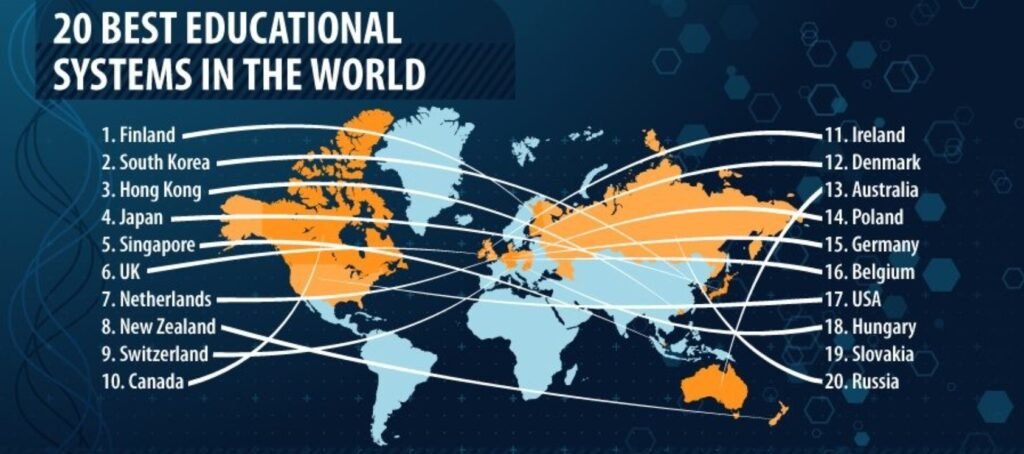Top 10 Best Education Systems in the World: Global Ranking 2024
Education Systems in the World
Education is the foundation of a country’s growth, innovation, and competitiveness in the global economy. In 2024, several countries continue to demonstrate their commitment to providing high-quality education through continuous improvement in teaching standards, curriculum development, and student engagement. Here’s an in-depth look at the top 10 best education systems in the world, according to the latest global rankings:

1. Finland
- Key Features:
- Student-Centric Approach: Finland’s education system emphasizes the individual learning pace of students, making it highly student-focused.
- Less Pressure: Finnish schools avoid standardized tests and have shorter school days, reducing student stress.
- Equal Opportunities: Every student, regardless of socio-economic background, has equal access to education.
- Highly Qualified Teachers: Teachers in Finland are required to have a master’s degree, making them highly skilled and respected professionals.
- Standout Programs: Creative problem-solving and critical thinking are highly prioritized.
2. South Korea
- Key Features:
- Intensive Curriculum: South Korea’s education system is known for its rigorous academic curriculum and long school hours.
- Technology Integration: High-tech classrooms and digital education are prevalent, keeping students at the cutting edge of global education.
- Private Tutoring: The “Hagwon” system (private tutoring academies) plays a significant role in student achievement.
- Focus Areas: Math and science are particularly strong in South Korea.
3. Singapore
- Key Features:
- Excellence in STEM: Singapore excels in science, technology, engineering, and mathematics (STEM), consistently ranking among the top in international assessments.
- Teacher Training: There’s a strong emphasis on continual professional development for teachers.
- Meritocracy: Students are assessed frequently, and the education system rewards merit.
- Global Recognition: Singaporean students often score the highest in the PISA (Programme for International Student Assessment) rankings.
4. Japan
- Key Features:
- Holistic Development: Japanese schools emphasize not just academics but also moral education, community engagement, and physical health.
- Strong Discipline: The system fosters discipline and respect for teachers.
- Collaborative Learning: Peer learning and collaboration are key components of the classroom environment.
- Notable Achievements: Japan is renowned for producing top-tier students in mathematics and science.
5. Canada
Key Features:
- Inclusive and Diverse: Canada’s education system is designed to accommodate students from various cultural backgrounds, with a strong focus on inclusivity.
- Public Education Focus: High-quality public schooling is available across provinces.
- Bilingual Education: Many Canadian students are taught in both English and French, giving them linguistic advantages.
Higher Education: Canadian universities are globally renowned, attracting students from across the world.
6. Denmark
Key Features:
- Free Education: Denmark offers free access to both primary and higher education, making it accessible to all citizens.
- Focus on Creativity: Danish schools emphasize creativity, innovation, and critical thinking from an early age.
- Teacher-Student Relationship: There’s a strong emphasis on building positive relationships between teachers and students, leading to better learning outcomes.
Key Advantage: Denmark ranks high in student satisfaction and well-being.
7. Netherlands
Key Features:
- Flexible School System: The Dutch education system allows students to choose their academic paths, from vocational to university preparatory programs.
- Bilingual Education: Dutch students are often multilingual, with English taught from a young age.
- Student-Centered Learning: Students are encouraged to be independent and develop critical thinking skills.
Technology Integration: Dutch schools are known for integrating technology effectively into the classroom.
8. Sweden
Key Features:
- Equal Access: Sweden’s education system focuses on providing equal access to system for all students, regardless of socio-economic background.
- Student Autonomy: Swedish schools allow students a great deal of autonomy and encourage self-directed learning.
- Innovative Teaching Methods: The system embraces modern and innovative teaching techniques.
University System: Sweden’s universities are research-driven and offer high-quality higher education.
9. Australia
Key Features:
- Internationally Recognized Degrees: Australian universities are ranked among the best globally, with degrees that are recognized and respected worldwide.
- Focus on Innovation: Schools in Australia focus on creativity, problem-solving, and entrepreneurial skills.
- Multicultural Classrooms: Australia has a diverse student population, providing a unique, multicultural learning environment.
Key Area of Strength: Australia is known for its strong vocational education and training (VET) system.
10. Germany
Key Features:
- Dual Education System: Germany’s dual education system combines classroom instruction with hands-on work experience, particularly in technical fields.
- Tuition-Free Universities: Public universities in Germany offer tuition-free to both domestic and international students.
- High Standards in Science and Technology: Germany consistently produces top talent in science, engineering, and research.
Global Reputation: German degrees, particularly in fields like engineering and physics, are highly regarded worldwide.
Factors in Ranking the Best Education Systems:

The global ranking for the best education systems is determined by a combination of factors, including:
- Quality of Teaching: Evaluated by teacher training, teaching methods, and learning outcomes.
- Student Performance: Based on international assessments such as PISA and TIMSS.
- Accessibility: Whether education is free or affordable, and available to all socio-economic groups.
- Innovation in Education: The integration of technology and modern teaching practices.
- Global Impact: The influence of the education system on the global economy and innovation.
Conclusion:
In 2024, the education systems in these top 10 countries continue to set benchmarks for excellence. While each system has its unique strengths, they all share a commitment to providing high-quality education, fostering innovation, and preparing students for a rapidly changing world.
As global competition intensifies, these countries remain at the forefront of education innovation, ensuring that their students are well-equipped to meet the challenges of the future.
World’s Top 5 Research Breakthroughs That Are Changing Our Future














Post Comment